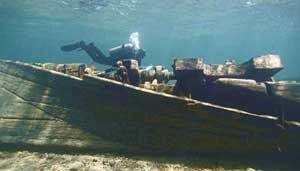
Shipwrecks are the stuff of epic tales and imagination. Some sank in battle, some in transit. They were war machines, whalers and luxury cruise liners.
Their doomed crew and passengers became legends. Rich and poor, from Gilded Age millionaires luxuriating at sea to sailors and deckhands in service to their country.
Shipwrecks have been honored in story and song through the centuries, from the Edmund Fitzgerald of Gordon Lightfoot’s song to Coleridge’s The Rime of the Ancient Mariner and Melville’s Moby-Dick. Even Shakespeare had his say in The Tempest, when the spirit Ariel sings, “Full fathom five thy father lies,” to the shipwrecked Ferdinand.
About 3,000 ships and submarines of many countries are thought to be sunken in America’s national marine sanctuary waters. NOAA scientists, oceanographers and divers have discovered 400 sites – and they’ve helped find many more.
Where NOAA comes in
When the wreck sites fall in sanctuary waters, NOAA is responsible for preserving and protecting the ships and their artifacts on behalf of our country’s maritime heritage.
Some wrecks still hold the remains of passengers and sailors. Navy wrecks are protected under the Sunken Military Craft Act and foreign vessels are protected under international law as gravesites.
But all sunken ships open a window into another time and another age when ironclads fought, enemy submarines prowled the coasts and cruise ships succumbed to the deep.
Source: NOAA
